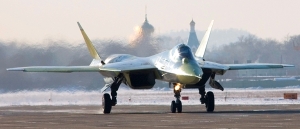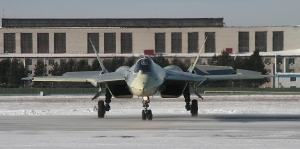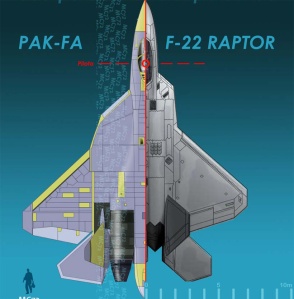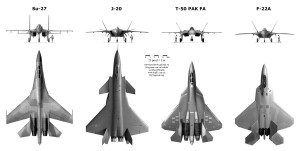
The first stealth fighter, the American F-117A, was designed in the 1970s using a novel mathematical theory for determining radar cross-sections of general three-dimensional bodies, and optimizing it subject to constraints. Ben Rich, chief of Lockheed’s Advanced Development Projects division (the so-called `Skunk Works’), wrote that “the Rosetta Stone breakthrough for stealth technology” was a new theory developed by Pyotr Ya. Ufimtsev, not a new development in engineering. Although the theory was conceived at the height of cold war tensions in the mid-1970’s, it was instigated by a research paper published by this Soviet radar engineer.
In late January 2010, the PAK FA made its maiden flight, ushering in an end to an era of US dominance of stealth, fifth generation fighter aircraft. Military analysts of every shade and nation spent endless times speculating and awaited the first flight with sleepless nights and over bitter arguments about its final configuration, for the PAK FA was kept so secretive that none other than a very choice few knew what it would look like.

Combat aircraft are the spear tip of any military power, and play a pivotal role in air warfare. And in today’s day and age, any nation that has the decisive advantage in the air war, dominates the ground war, and by extension, the political arena. The PAK FA, also known as the T-50 and possibly to be known in its final version as the Su-50, is an aircraft that not only Russia, but the world needed. For the unipolar world that ushered in an American Empire has increasingly become an unfair and unjust world where American arrogance and exploitation is increasingly creating fiction, not only with the Muslim world but with such powers that have had the most to lose and least to gain, such as China, Russia and Brazil.
Comparison with Other 5th Generation –

The PAK FA is an answer to the US F-22, a fifth generation fighter that till now had no equal. A comparative analysis will follow later in this paper, but for now it suffices to say that it contends with the F-22 on stealth, aerodynamic performance and sensor sophistication and capability, as well as in cost, maintenance and practicality.
It must be understood that the T-50 is not merely a combat aircraft, it is an investment in technology and engineering that has implications for Russian industry, and has economic implications for Russia as well as for Su-50 customers who may thus be able to avoid conflict by deterrence. As a superficial example, two squadrons of this aircraft with Iran would dispel all possibilities of an Israeli strike on that nation.
Comparison
The PAK FA compares most favorably to the F-22, surpassing it on a number of parameters while sacrificing certain parameters to the F-22. The relationship is not dissimilar to that between the early FLANKER and the F-15. Primarily, the F-22 is stealthier while the PAK FA is likely to exceed the F-22 in the critical arena of a high-high combat profile. The PAK FA also has a bigger weapons bay and greater fuel capacity. In terms of operational capability and cost, the PAK FA wins hands down to the high cost and complicated maintenance of the F-22, while the PAK FA is said to be an improvement over the maintainability of the Su-27. It could cost a third of an F-22 by its greater simplicity and managed tradeoffs as well as greater production run (being procured by both Russia and India if not any other country).

Until the US produces the next generation of aircraft, this spells the end of their monopoly in 5th generation aircraft and is likely to usher in other players such as China and perhaps give enough hope to Europe to produce its own fighter rather than sink to the humiliation to their sovereignty that the F-35 provides.
The Euro-canards now appear out-dated and out-classed, a situation unlikely to sit well with Western Europe. Given the attitude of the US towards her allies vis-a-vis the F-35, Europe now finds itself between a rock and a hard place. It is the contention of this author that Europe will get together and build a fifth generation fighter, for the spirit of Europe has not been one to see its technological edge corrode or to be demeaned by external powers.
General Analysis
Basic Aerodynamics
The wings on the PAK FA are large and well-swept, optimized for supersonic flight and for high(er) altitudes. In comparison to the F-22, given even remotely comparable engines, the PAK FA should be able to fly faster, for longer and supercruise more effectively (with lower fuel consumption and greater speed).
The all-wing shape of the PAK FA follows the same principles that was so successful with the Su-27 FLANKER and the MiG-29 FULCRUM and not only provides lift, but also provides ample space (along with the large wings) for massive fuel and/or weapons bays. Reducing drag, increasing range and payload and creating lift and stands in good light compared to the F-22s design.
Air Intakes
CARET inlets of the air intakes are useful for “wave riding”, generating increased lift for the airframe. This allows lower RCS and increased airflow. With the long length of its horizontal wedged edge (of the inlet) additionally helps lift. Large, moveable Leading Edge Root Extensions (LERX) over the inlets are highly innovative and perhaps plays a role in making the PAK FA super-maneuverable. It is not a flap-like structure but perhaps more like an aileron and behaves in someways perhaps like a canard.
This is an interesting innovation and also provides a solution for the PAK FA in managing air-flow over the wing and onto the slanted stabilizers, solving problems of a twin-tailed delta configuration.
Angled Twin Stabilizers
The twin all-moving stabilizers are innovative in that they can be smaller and have the same effect as a larger conventional stabilizer. Given that the PAK FA also has 3D Thrust Vector Controls (TVC), this makes the PAKFA a fundamentally more stealthy design given that large stabilizers contribute to RCS significantly. Other advantages include reduced weight, stability in hard maneuvering and the ability to go supersonic in a turn.
Conclusion
Just as the US is being challenged in global economics and is seeing a resistance to its political imperialism and empire building, the world of military aviation also mirrors this challenge in the shape of such aircraft as the French Rafale, the Chinese J-10 and the Indian Su-30MKI. The PAK FA represents the pinnacle of this challenge and puts the ball squarely back to the US court. Can the US now move on to another generation of combat aircraft? With a failing economy, ever decreasing competitiveness, ever increasing dependence on government spending and increasing dependence on indirectly taxing the rest of the world through dollar depreciation, spending billions on a new fighter project may be outside the realms of the US Empire. As such, this may spell the beginning of the end of the US as the center of a uni-polar world. That is exactly what the PAK FA challenges and symbolizes in its capabilities.
For more details you read article on PAK FA at wikipedia
<a href=”https://plus.google.com/115367478953149898310″ rel=”publisher”>Google+</a>




This is the proper blog if you wants to discover this matter. You realize a great deal its nearly hard to argue with you (not really that I actually might want�HaHa). You definitely put a new rewrite on a matter thats been written about for a long time. Great things, just excellent!
great.russia again starting the cold war,left by ts native ussr.